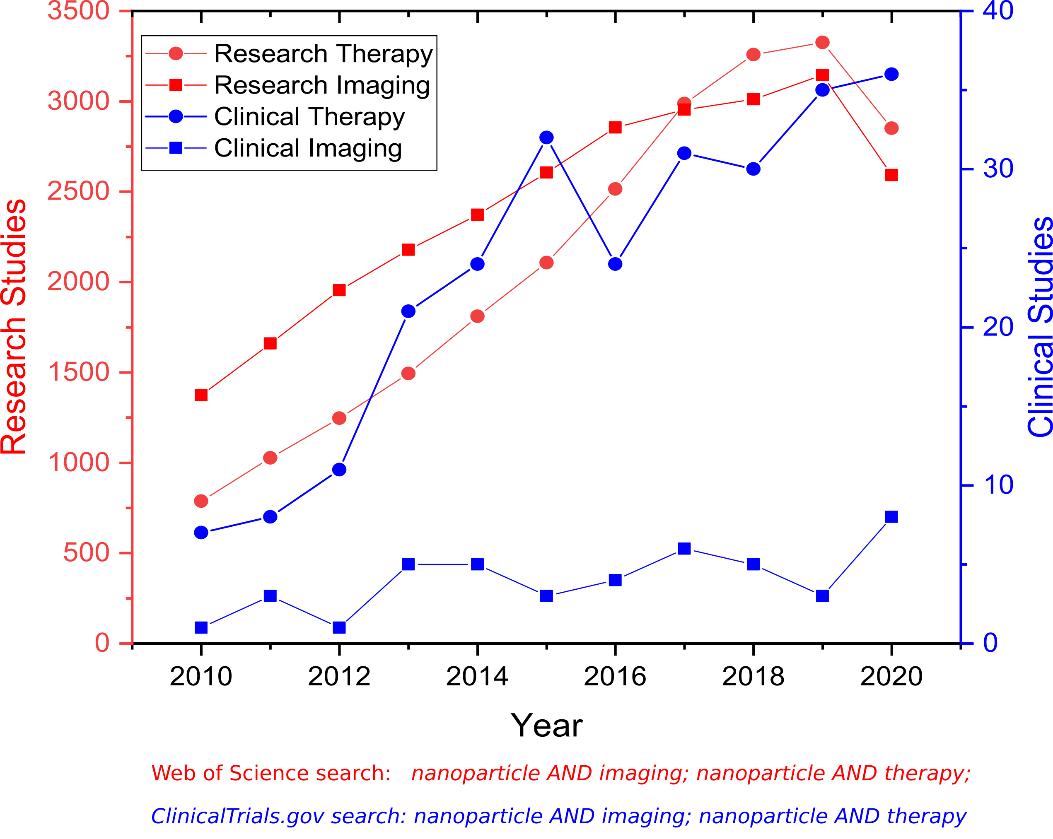Recent Advancements in Nanoparticle Based Imaging and Therapy
A special issue of Journal of Nanotheranostics (ISSN 2624-845X).
Deadline for manuscript submissions: closed (30 September 2021) | Viewed by 18625
Special Issue Editors
Interests: application of radiotheranostics to oncology and neurology; molecular imaging; continuous production of PET radionuclides using flow technologies; nanotechnology; underdeveloped radionuclides for radiotheranostics
Special Issue Information
Dear Colleagues,
Nanoparticles are defined as a nanosized material, typically under 100 nm. Over the last two decades, there has been an unabated interest in expanding the role of nanotechnology into medicine. The nanosized formulations are designed to improve the target site accumulation, thus maximizing the drug’s efficacy and minimizing toxicity. For therapy, nanoparticles can act as delivery vehicles carrying drugs to their biological targets. When loaded with the appropriate contrast agent or radionuclides, nanoparticles can serve as optical, magnetic resonance imaging (MRI), single-photon emission computed tomography (SPECT), and positron emission tomography (PET) imaging probes. The continuous research and development effort led to remarkable scientific progress but also highlighted considerable clinical challenges. The cytotoxicity, limited in-vivo efficacy, and immune response to nanoparticles remain major hurdles for clinical translation. The other challenge is the need for appropriate characterization of nanoparticles for clinical use and the issue of scale-up and batch-to-batch variations. The dichotomy between academic research and the clinical translation is further reflected in the number of corresponding publications over the years as shown in Figure 1. Based on this analysis, only ~1% of nanoparticle-based research is translated into clinical therapy studies, and ~0.4% of imaging research is translated into clinical imaging studies. Therefore, we propose this thematic issue to inform and guide the scientific community by inviting experts in the field to provide their critical findings, systematic, perspective, and education reviews to reduce this gap and overcome major challenges faced in the clinical translation of nanoparticle-based therapy and imaging.

Research and clinical publications in the field of nanotheranostics.
This thematic issue will cover the following:
- Targeted nanotheranostics for imaging and drug delivery applications
- Novel nanoplatforms for imaging and or radiotheranostics applications
- Nanosized multimodal imaging probes and superparamagnetic iron oxide (SPIO) nanoparticles
- Novel approaches to loading, controlled release, chelation, and conjugation strategy of theranostic radionuclides and conjugates
- Preclinical evaluation of novel nanoparticles
- Novel biochemical mechanism for nanoparticle internalization (disease-specific or case study)
- Radiomics-based patient stratification strategies
- Translating preclinical efficacy and toxicology to clinical outcome
- Regulatory challenges and approach towards clinical translation
Dr. Fedor Zhuravlev
Dr. Mukesh K. Pandey
Guest Editors
Manuscript Submission Information
Manuscripts should be submitted online at www.mdpi.com by registering and logging in to this website. Once you are registered, click here to go to the submission form. Manuscripts can be submitted until the deadline. All submissions that pass pre-check are peer-reviewed. Accepted papers will be published continuously in the journal (as soon as accepted) and will be listed together on the special issue website. Research articles, review articles as well as short communications are invited. For planned papers, a title and short abstract (about 100 words) can be sent to the Editorial Office for announcement on this website.
Submitted manuscripts should not have been published previously, nor be under consideration for publication elsewhere (except conference proceedings papers). All manuscripts are thoroughly refereed through a single-blind peer-review process. A guide for authors and other relevant information for submission of manuscripts is available on the Instructions for Authors page. Journal of Nanotheranostics is an international peer-reviewed open access quarterly journal published by MDPI.
Please visit the Instructions for Authors page before submitting a manuscript. The Article Processing Charge (APC) for publication in this open access journal is 1000 CHF (Swiss Francs). Submitted papers should be well formatted and use good English. Authors may use MDPI's English editing service prior to publication or during author revisions.
Keywords
- nanoparticles
- imaging
- radiotherapy
- nanotheranostics




